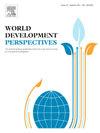When does new information encourage adoption, and where can we observe it: A synthesis of 3ie’s thematic window on agricultural innovation
IF 2.2
Q2 DEVELOPMENT STUDIES
引用次数: 0
Abstract
We present a synthesis of 3ie’s Thematic Window on Agricultural Innovations − 13 evaluations of interventions to improve smallholder innovation and technology adoption, largely through improved access to and information about inputs, techniques, and markets. We ask 1) under what conditions does information about a technology improve understanding, adoption, and further downstream impacts; and 2) how do conditions of the evaluation (as a project) constrain our ability to observe impacts? Most of the 13 interventions involved information treatments (SMS text messaging, demonstration plots, farmer field days, and farmer field schools). While most information interventions lead to greater reported awareness of the focal technique or input, we observe fewer impacts further down the impact pathways – on adoption, yield gains, or improvements to wellbeing, with several possible explanations. First, more complicated techniques like integrated soil fertility management (ISFM) require deeper engagement, so that (for example) farmer field schools have greater effect than farmer field days. This highlights the tension between scalability and effective learning in improving extension. Second, many of the interventions were short (1–2 years), whereas diffusion of knowledge around the intervention (as well as benefits from adoption) can take longer to be realized. Third, all agricultural interventions are at the whims of a variable climate, where improved weather conditions from baseline to endline can mask possible benefits of an encouraged practice. We consider these three findings jointly to discuss how to better fold climate variation and information diffusion into consideration of validity and appropriate time scales for evaluation.
什么时候新信息会鼓励采用,我们在哪里可以观察到:3ie关于农业创新的主题窗口的综合
我们综合了3ie的农业创新专题窗口- 13对改善小农创新和技术采用的干预措施的评估,主要是通过改善对投入物、技术和市场的获取和信息。我们的问题是:1)关于一项技术的信息在什么条件下能够提高理解、采用和进一步的下游影响;2)评估的条件(作为一个项目)如何限制我们观察影响的能力?13项干预措施中的大多数涉及信息处理(短信、示范地块、农民田间日和农民田间学校)。虽然大多数信息干预导致了对重点技术或投入的更大认识,但我们观察到,在影响途径的下游,对采用、产量增加或福祉改善的影响较小,并有几种可能的解释。首先,像综合土壤肥力管理(ISFM)这样更复杂的技术需要更深入的参与,因此(例如)农民田间学校比农民田间日有更大的效果。这突出了可扩展性和有效学习之间的紧张关系。其次,许多干预措施都是短期的(1-2年),而围绕干预措施的知识传播(以及采用干预措施带来的好处)可能需要更长的时间才能实现。第三,所有的农业干预措施都受到气候变化的影响,从基线到终点的天气条件改善可能会掩盖鼓励实践的可能好处。我们将这三个发现结合起来讨论如何更好地将气候变化和信息扩散纳入有效性和适当的时间尺度进行评估。
本文章由计算机程序翻译,如有差异,请以英文原文为准。
求助全文
约1分钟内获得全文
求助全文
来源期刊

World Development Perspectives
Social Sciences-Sociology and Political Science
CiteScore
4.50
自引率
0.00%
发文量
65
审稿时长
84 days
期刊介绍:
World Development Perspectives is a multi-disciplinary journal of international development. It seeks to explore ways of improving human well-being by examining the performance and impact of interventions designed to address issues related to: poverty alleviation, public health and malnutrition, agricultural production, natural resource governance, globalization and transnational processes, technological progress, gender and social discrimination, and participation in economic and political life. Above all, we are particularly interested in the role of historical, legal, social, economic, political, biophysical, and/or ecological contexts in shaping development processes and outcomes.
 求助内容:
求助内容: 应助结果提醒方式:
应助结果提醒方式:


